AE Aurigae is a hot blue main sequence star located 1,320 light-years away in the northern constellation Auriga. With an average apparent magnitude of 5.96, it is visible to the unaided eye in exceptionally good conditions. The star illuminates the Flaming Star Nebula (IC 405), an emission and reflection nebula visible in small telescopes.
Star type
AE Aurigae is a hot blue star of the spectral type O9.5V. It is a young star that is still burning hydrogen in its core. With a mass 23 times that of the Sun, it will not be long before it evolves away from the main sequence and becomes a luminous supergiant. When it reaches the end of its life, it is destined to go out as a supernova.
AE Aurigae has a radius 7.47 times that of the Sun and it spins at 25 km/s. With a surface temperature of 33,000 K, it is 59,000 times more luminous than the Sun. It has an estimated age of 2.6 million years.
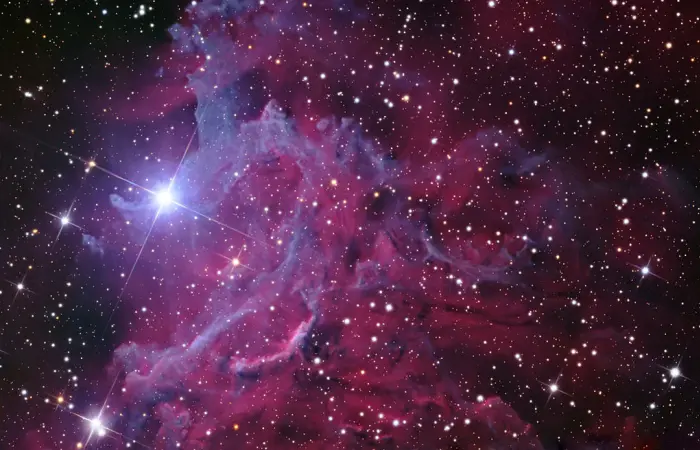
AE Aurigae and the Flaming Star Nebula (IC 405), image credit: Adam Block/Mount Lemmon SkyCenter/University of Arizona (CC BY-SA 4.0)
The star is classified as an Orion variable. These stars show irregular and eruptive brightness variations of up to several magnitudes. They are very young stars, and it is believed that they become regular when they reach the zero-age main sequence. The brightness of AE Aurigae has been observed to vary between magnitudes 5.78 and 6.08.
AE Aurigae is a runaway star. It is believed to have been expelled from its birthplace in the Orion Nebula soon after forming, likely in a collision of two groups of binary stars. The hot blue stars Mu Columbae and 53 Arietis in the constellations Columba and Aries are believed to have been expelled at the same time, about 2.5 million years ago. The trajectory of these stars has been traced to the Trapezium Cluster, the central young open cluster in the Orion Nebula. The binary system Iota Orionis (Hatysa) in Orion’s Sword is believed to have been the other system in the collision.
Flaming Star Nebula (IC 405)
AE Aurigae illuminates the Flaming Star Nebula (IC 405), a bright emission and reflection nebula located approximately 1,500 light-years away. The nebula has an apparent magnitude of 6 and can be observed in a small telescope. It has an apparent size of 37 by 19 arcminutes, corresponding to a physical diameter of about 5 light-years.
The cloud of interstellar hydrogen and carbon-rich dust is not the birthplace of AE Aurigae. It is an unrelated hydrogen gas cloud that the star is currently passing through at a very high speed.
As it moves through the nebula’s clouds of dust and gas, AE Aurigae creates a powerful bow shock. In 2012, astronomers detected X-ray emission from the bow shock 30 arcseconds northeast of the star.
In about 20,000 years, AE Auriga will leave the nebula and the glowing clouds will fade from view.
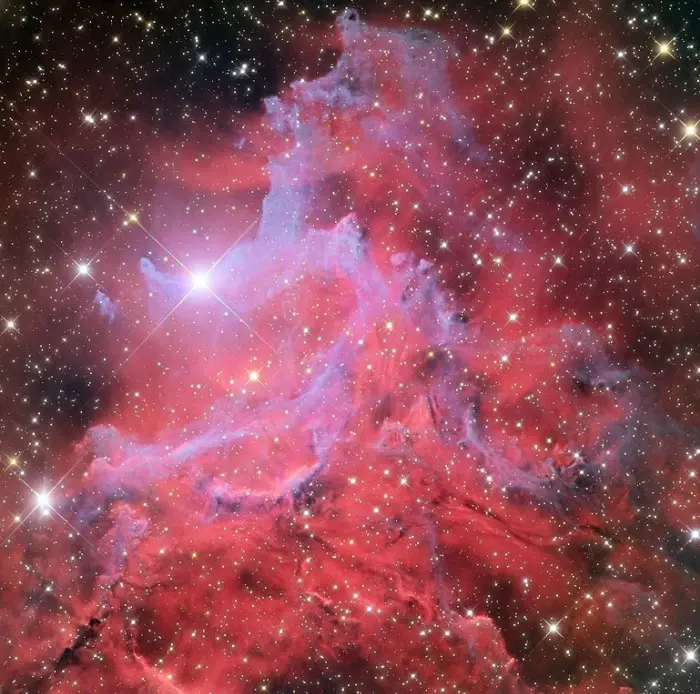
The Flaming Star Nebula (IC 405), image credit: Adam Block/Mount Lemmon SkyCenter/University of Arizona (CC BY-SA 3.0)
Facts
AE Aurigae is sometimes called Schaeberle’s Flaming Star, after the German-born American astronomer John Martin Schaeberle, who discovered the emission nebula IC 405 on March 21, 1892.
German astronomer and astrophotographer Max Wolf and Hungarian astrophotographer Eugen von Gothard discovered the Flaming Star Nebula independently shortly after. Max Wolf was the first to refer to AE Aurigae as the “flaming star.” He described it as a “burning body from which several enormous curved flames seem to break out like gigantic prominences.”
The Flaming Star Nebula is listed as Caldwell 31 in Sir Patrick Moore’s Caldwell catalogue of deep sky objects that can be observed by amateur astronomers.
Mu Columbae is believed to have been AE Aurigae’s binary companion before the two stars collided with another binary system and were expelled along different trajectories. The stars are moving away at the same speed, 127 km/s. Their common point of origin intersects with Iota Orionis. Like AE Aurigae, Mu Columbae is a supernova candidate. It is an O-type star with 16 times the Sun’s mass, located approximately 1,300 light-years away in the southern constellation Columba (the Dove).
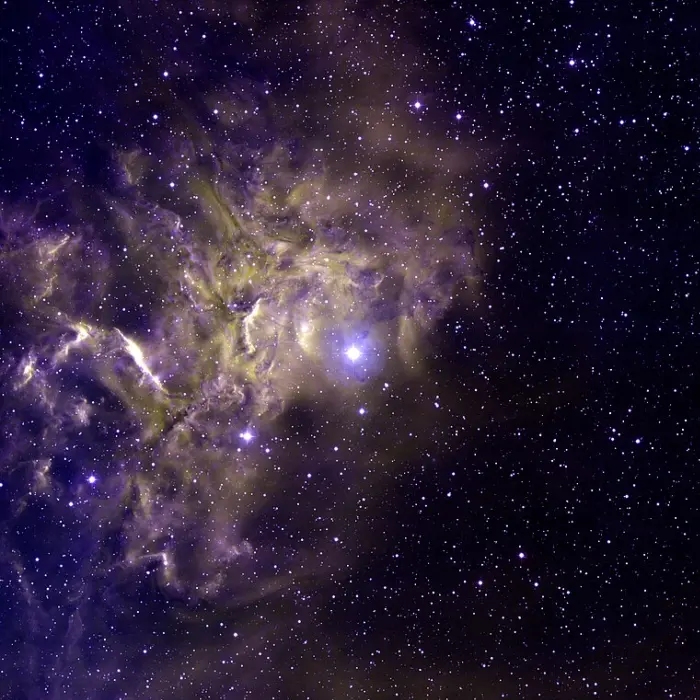
This spectacular image of the star AE Aurigae and its surrounding nebulosity was taken at the National Science Foundation’s 0.9-meter telescope on Kitt Peak with the NOAO Mosaic CCD camera. Located in the constellation of Auriga, the Charioteer, AE Aurigae is the bright blue star at the center of the image. The incredible energy from this hot, massive star is energizing the surrounding gas, causing it to glow dramatically. As a result it is also known as “the flaming star”. This false-color image was created by combining emission-line images taken in Hydrogen-alpha (yellow), Oxygen [OIII] (violet) and Sulfur [SII] (blue). Image credit: T.A.Rector and B.A.Wolpa/NOIRLab/NSF/AURA (CC BY 4.0)
Name
AE Aurigae does not have a proper name. It is commonly referred to by its variable star designation AE Aurigae. The star is informally known as the Flaming Star because it illuminates the surrounding nebula IC 405.
AE Aurigae is catalogued as HD 34078 in the Henry Draper Catalogue, HR 1712 in the Bright Star Catalogue, and HIP 24575 in the Hipparcos Catalogue.
Location
AE Aurigae lies within Auriga’s hexagon, a prominent northern asterism that dominates the constellation of the Charioteer (Auriga). The star can be found at the intersection of the imaginary lines drawn from Elnath through Almaaz and from Mahasim to Hassaleh. These stars form Auriga’s hexagon with Capella and Menkalinan. Capella, Menkalinan, Mahasim, Hassaleh and Almaaz are the brightest stars of Auriga, while Elnath is the second brightest star in Taurus and marks the Bull’s northern horn.
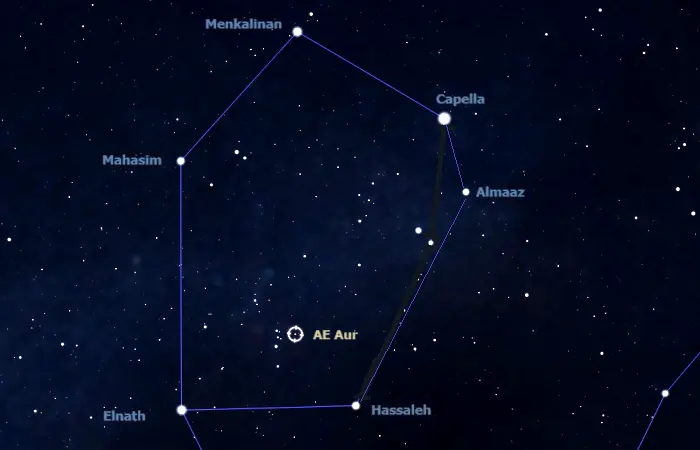
AE Aurigae location, image: Stellarium
AE Aurigae and the Flaming Star Nebula appear in a region rich with deep sky objects. The Tadpole Nebula (IC 410), the Spider and Fly nebulae (IC 417 and NGC 1931), and the bright open clusters Messier 36, Messier 38 all lie in the same area.
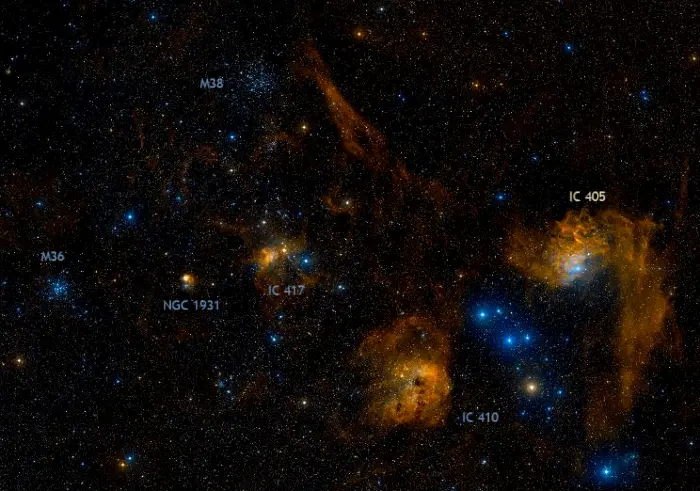
The Flaming Star Nebula (IC 405), the Spider Nebula (IC 417), the Fly Nebula (NGC 1931), the Tadpole Nebula (IC 410), Messier 36 and Messier 38, image: Wikisky
Constellation
AE Aurigae is located in the constellation Auriga. Representing the Charioteer, Auriga is one of the most recognizable northern constellations. Its brightest stars form Auriga’s hexagon with Elnath in the neighbouring Taurus. Capella, Auriga’s brightest star, is the sixth brightest star in the sky.
Auriga is the 21st largest constellation in the sky (out of 88), stretching across 657 square degrees of the northern sky. It is one of the Greek constellations, catalogued by the Greek astronomer Ptolemy in his Almagest in the 2nd century CE. In Greek mythology, Auriga is associated with Erichthonius, the inventor of the quadriga (the four-horse chariot) and with Amalthea, the goat that nursed Zeus and kept him hidden from his father Cronos.
Notable stars in Auriga include the quadruple system Alpha Aurigae (Capella), the Alpha2 Canum Venaticorum variable Mahasim (Theta Aurigae), the Algol-type variables Menkalinan (Beta Aurigae), Almaaz (Epsilon Aurigae), and Saclateni (Zeta Aurigae), the hot blue star Haedus (Eta Aurigae), and the K-type giant Hassaleh (Iota Aurigae).
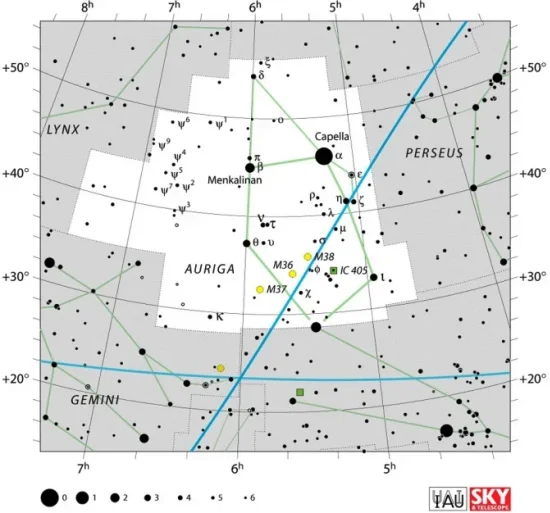
Auriga constellation map by IAU and Sky&Telescope magazine
Auriga hosts a number of relatively bright deep sky objects. These include the Messier open clusters Messier 36, Messier 37 and Messier 38, the open clusters NGC 2281 and the Kite Cluster (NGC 1664), the Westbrook Nebula (CRL 618), the Flaming Star Nebula (IC 405), the Tadpole Nebula (IC 410), the Spider Nebula (IC 417), and the Fly Nebula (NGC 1931).
The best time of the year to observe AE Aurigae and other stars and deep sky objects in Auriga is during the months of February and March, when the celestial Charioteer appears higher above the horizon in the early evening. The entire constellation is visible from locations north of the latitude 40° S.
The 10 brightest stars in Auriga are Capella (Alpha Aur, mag. 0.08), Menkalinan (Beta Aur, mag. 1.90), Mahasim (Theta Aur, mag. 2.62 – 2.70), Hassaleh (Iota Aur, mag. 2.69), Almaaz (Epsilon Aur, mag. 2.92 – 3.83), Haedus (Eta Aur, mag. 3.18), Saclateni (Zeta Aur, mag. 3.70 -3.97), Delta Aurigae (mag. 3.715), Nu Aurigae (mag. 3.957), and Pi Aurigae (mag. 4.25).
AE Aurigae
| Spectral class | O9.5V |
| Variable type | Orion variable |
| U-B colour index | -0.70 |
| B-V colour index | +0.22 |
| Apparent magnitude | 5.96 (5.78 – 6.08) |
| Distance | 1,320 ± 40 light-years (410 ± 10 parsecs) |
| Parallax | 2.574 ± 0.034 mas |
| Radial velocity | 56.70 ± 0.6 km/s |
| Proper motion | RA: -4.747 ± 0.046 mas/yr |
| Dec.: 43.538 ± 0.033 mas/yr | |
| Mass | 23 M☉ |
| Luminosity | 59,000 L☉ |
| Radius | 7.47 R☉ |
| Temperature | 33,000 K |
| Rotational velocity | 25 km/s |
| Surface gravity | 4.0 cgs |
| Age | 2.6 million years |
| Constellation | Auriga |
| Right ascension | 05h 16m 18.1493304816s |
| Declination | +34° 18′ 44.344404000″ |
| Names and designations | AE Aurigae, AE Aur, HD 34078, HR 1712, HIP 24575, SAO 57816, BD+34°980, AG+34°542, GC 6429, GCRV 3123, ALS 8255, PPM 70112, PLX 1190.00, JP11 1013, IRAS 05130+3415, 2MASS J05161814+3418443, AAVSO 0509+34, UBV M 10749, GSC 02398-00894, MCW 290, TYC 2398-894-1, Gaia DR1 182071566417283328, Gaia DR2 182071570715713024, Gaia DR3 182071570715713024, ADS 3843 A, CCDM J05163+3419, WDS J05163+3419 |